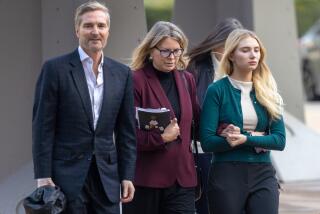Brain expert rebuts Spector theory
- Share via
A brain specialist disputed a key claim by the defense team in the Phil Spector murder trial that a dying Lana Clarkson coughed blood onto Spector.
John Andrews, a forensic neuropathologist who examined Clarkson’s brain and spinal cord as a consultant to the Los Angeles County coroner, testified that Clarkson could not have breathed, coughed, spit or sneezed after she was shot.
The defense says Clarkson coughed the blood onto Spector as he rendered aid after she shot herself.
The jacket Spector was wearing was spotted with blood, which prosecutors say came from the actress’ wound when the record producer shot her. Clarkson was found dead in the producer’s Alhambra mansion Feb. 3, 2003. Spector is charged with second-degree murder. Andrews was the final witness for the prosecution.
The case is expected to go to the jury sometime after Labor Day.
Michael Baden, a prominent forensic pathologist hired by the defense, said Clarkson’s lungs were filled with blood and bodily fluids, indicating she breathed for several minutes after she was shot. Baden said Clarkson’s spinal cord might have been only partially severed when she was shot, splitting completely when her body was later moved.
“I can’t believe that,” Andrews said of Baden’s theory.
Andrews said he believed that Clarkson’s spinal cord was completely severed by the bullet that killed her. The bullet was nearly the same width as the section of spinal cord it struck, he said, and penetrated the cord in the center.
Even if the cord was not completely cut, he said, a person with such spinal cord damage would suffer “spinal shock,” a condition of temporary paralysis.
Spinal shock, Andrews said, is “a well-known, well-described phenomenon.” He said that in preparing for his testimony, he found 1,800 hits when searching for “spinal shock” on a medical website.
A soft-spoken man, Andrews repeatedly said “you don’t need to take my word for it” when making points, noting that he had provided references to scientific studies supporting his views.
Andrews called Baden’s theory “an innovative thought” and said after hearing it that he reevaluated his own conclusions about Clarkson’s death.
“One of the things we do as forensic [scientists] is try to prove ourselves wrong,” Andrews said.
But he said the blood and fluids that swelled Clarkson’s lungs did not indicate that she was breathing after being shot. Andrews said blood and fluids could have entered Clarkson’s lungs during the several hours her body was propped upright in the chair in which she was found, or when her body was moved and handled by the coroner’s staff. Her heart also could have continued to beat for a short time after she was shot, creating enough blood pressure to move blood and fluid to the lungs, he said.
Spector attorney Christopher J. Plourd’s cross-examination focused largely on Andrews’ relative lack of experience compared to the retired chief medical examiners who testified for the defense. Andrews did not become a forensic neuropathologist until 1999.
After Andrews stepped down from the witness stand, the defense began putting on final evidence, known as surrebuttal. The prosecution’s just-completed phase was called rebuttal, and by law had to be limited to refuting defense testimony. Surrebuttal, in turn, must address prosecution rebuttal testimony only.
The defense began with Daniel Stark, a paramedic who treated Clarkson when she broke her wrists in a fall at a 2001 Christmas party. Stark said Clarkson’s breath smelled of alcohol, her speech was slurred and he believed that she was drunk. His testimony contradicted that of his partner, who said he did not find Clarkson intoxicated.
The defense contends Clarkson abused alcohol and prescription medications, which affected her judgment and could have led her to impulsively shoot herself. For the remainder of its surrebuttal, the defense plans to call friends of Clarkson to testify about her drug use and depression and will bring back prominent forensic pathologist Werner Spitz, who earlier testified that Clarkson shot herself.
Testimony in the trial could conclude as early as today, but Judge Larry Paul Fidler said Wednesday that it would probably run into Monday.
More to Read
Sign up for Essential California
The most important California stories and recommendations in your inbox every morning.
You may occasionally receive promotional content from the Los Angeles Times.












